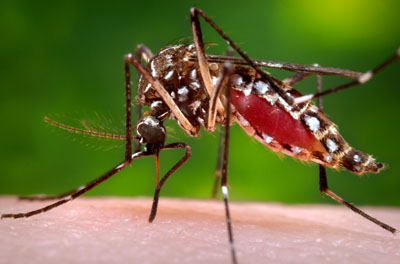
Aedes aegypti
The Shasta Mosquito & Vector Control District (SMVCD) has been receiving increased reports of aggressive day-biting mosquitoes, primarily in response to Aedes Aegypti mosquitoes (the yellow fever mosquitoes), a very aggressive mosquito that we find in Summer months and into the early Fall season. Since their arrival in Shasta County in 2020, our District has found increasing invasive Aedes populations, as well as spreading of habitat locations each year.
This invasive species of mosquito is different from many of our native mosquito species, because they prefer small habitats, even bottle-caps, as opposed to larger bodies of water like pools or ponds. They are very comfortable near humans and like to live in and around homes. You can find them in small pockets of water, like the saucers under flowerpots, pooled in gutters with leaves and debris, or in animal watering dishes and tires, among many other places. For a comprehensive list of common habitats, please see our full checklist.
“All of our residents play a key role in controlling mosquitoes. Every saucer dumped-out, gutter cleaned, and tire recycled, means hundreds less mosquitoes for the entire neighborhood,” said Darcy Little, District Manager.
While this species of mosquito can transmit Dengue, Zika, Yellow Fever, and Chikungunya, our District does not currently have these diseases circulating in our area. However, removing the invasive Aedes’ aquatic habitat can prevent them from becoming well established, and protect our community from future transmission.
Mosquitoes in California are responsible for transmitting serious viruses such as West Nile virus (WNV) and Dengue virus (DENV), which can cause debilitating cases of illness and even death. In 2024, there were 132 human cases of WNV and 12 deaths state-wide; of those, 1 case was confirmed in Shasta County. Additionally, in 2024, there were 720 human-cases of Dengue state-wide, of which 18 were locally transmitted in California.
SMVCD staff urges residents to take precautions to avoid mosquito bites by implementing the 4 Ds of protection:
• Drain any standing water that may produce mosquitoes, including old tires, buckets, gutters, flowerpots, and saucers. Some species of mosquitoes can lay their eggs in very small sources of water, like a bottle cap.
• Defend yourself and your home by using an effective insect repellent and making sure screens on doors and windows are in good condition.
• Dusk or Dawn, avoid outside activities during peak mosquito feeding times.
• Dress in long sleeves and pants when mosquitoes are active.
For more information about SMVCD’s services, West Nile virus, or new emerging mosquitoborne diseases, contact the Shasta Mosquito and Vector Control District at (530) 365-3768 or visit www.ShastaMosquito.org.
2025 Shasta County West Nile virus activity: 0 dead birds, 0 sentinel chickens, 2 mosquito samples, and 0 humans tested positive for West Nile virus.
2025 California West Nile virus activity: 138 dead birds, 49 sentinel chickens, 2500 mosquito samples, and 47 humans tested positive for West Nile virus.

